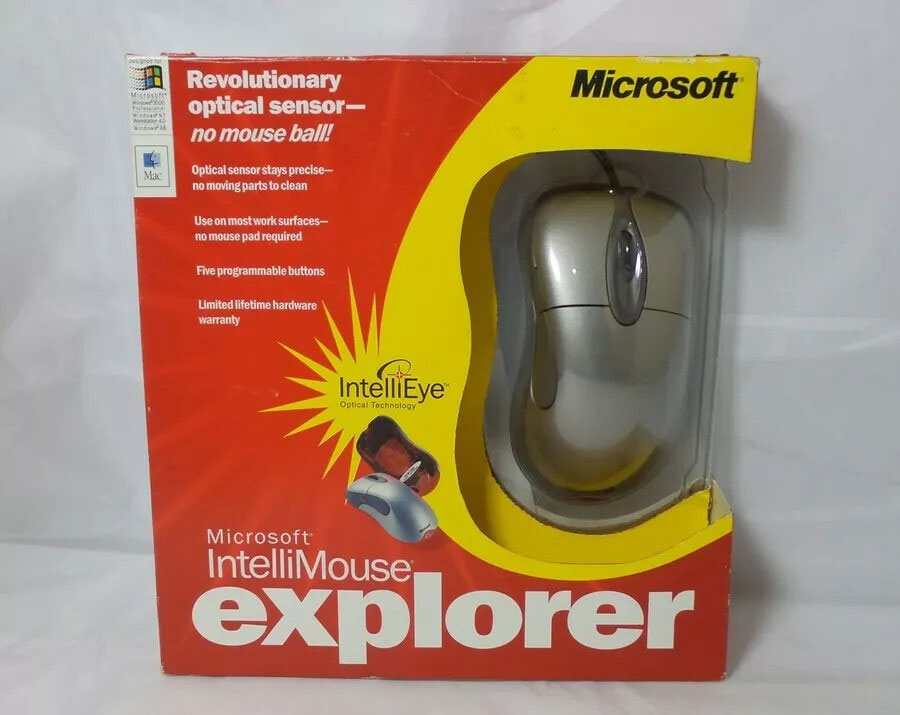25 years ago today, Microsoft launched one of the most successful lines of computer mice
In any field, there will be inventions that lay the foundation for the long-term development of an entire industry. On April 19, 1999, that actually happened to the PC mouse. Exactly 25 years ago, Microsoft first revealed its newest line of computer mice called IntelliMouse Explorer, and what followed was history.
In case you might not understand why IntelliMouse Explorer is a particularly important factor in the development of the PC accessory industry, there is a very simple reason: IntelliMouse Explorer is the first commercially produced product for the home PC segment to feature an optical sensor. Although this is not the first computer mouse line to incorporate this type of technology, the IntelliMouse Explorer is certainly the first product to use an optical sensor instead of a trackball that is produced for a mass market audience. .
Of course, Microsoft has been designing and manufacturing PC mice since long before that. The first Microsoft mouse model was marketed in May 1983. The company also announced the first product in the Intellimouse line in July 1996. This was one of the first mouse lines to have a scroll wheel, and the invention This extremely useful feature quickly became a standard feature on all subsequent computer mouse models until today.
However, the addition of a scroll wheel is just a prelude to the revolutionary ideas Microsoft wants to bring to IntelliMouse Explorer. The main highlight lies in optical sensor technology, developed by Agilent Technologies, then a subsidiary of HP before being separated into a separate business in 1999.
 25 years ago today, Microsoft launched one of the most successful lines of computer mice Picture 1
25 years ago today, Microsoft launched one of the most successful lines of computer mice Picture 1
Microsoft calls its version of optical sensor technology IntelliEye. Here's how the company describes the hardware configuration equipped on the IntelliMouse Explorer in the press release:
IntelliEye uses an optical sensor to capture high-resolution digital images at a rate of 1,500 images per second. The built-in digital signal processor compares those images and translates the changes into cursor movements on the screen. This technique, called image correlation processing, can perform 18 million instructions per second (MIPS) and delivers smoother, more precise cursor movements. Current mice only execute about 1.5 MIPS, meaning the Microsoft IntelliEye mouse is about 12 times smarter than a conventional mouse.
Of course, putting an optical sensor instead of using the older physical trackball technology inside most PC mouse products is a big change. People don't have to worry about the ball getting dirty, affecting the mouse dragging experience. The Intellieye optical sensor in IntelliMouse Explorer has solved many 'painful' problems of today for most PC mouse owners. In addition, the IntelliMouse Explorer also had a small light on the back of the mouse to emphasize that this was a very different product at the time.
In addition to the optical sensor, IntelliMouse Explorer is also equipped with two additional buttons (in addition to the two main buttons and scroll wheel). These two extra buttons on the left side, specifically designed for use with a web browser, have forward and backward functions by default. They can also be remapped to be used for many other PC features such as printing, copying documents, etc.
Microsoft sold IntelliMouse Explorer in late 1999 for $74.95 (about $150 at today's exchange rate). Besides, the company also sells the original Intellmouse design with IntelliEye sensor for $54.95. Not long after, old trackball mouse products from many other companies quietly became obsolete and no longer appeared on the market.
Riding on the momentum of success, Microsoft continued to launch new IntelliMouse and Intellimouse Explorer mouse products over the next few years. The most successful is probably the case of IntelliMouse Explorer 3.0 launched in 2006. It used the original IntelliMouse Explorer design but had a much faster 9,000 fps sensor, along with a series of other features designed specifically for PC gaming.
After more than a decade of pause, Microsoft brought back the IntellMouse brand with the Classic IntelliMouse version in 2017, followed by Microsoft Pro IntelliMouse in 2019. However, both have not achieved the expected success due to The market now has many high-quality mouse products, while Microsoft is no longer the innovative pioneer it was 25 years ago.
Those will be the last products in the IntelliMouse line. As you may know, Microsoft has decided to no longer manufacture or sell its mouse and keyboard accessories by 2023. However, earlier this year, Incase suddenly announced that it had acquired the rights to manufacture and sells a number of PC accessories designed by Microsoft. including mouse products. Perhaps Incase will include Intellimouse in one of its revived products someday.
You should read it
- 8 things to know when buying a computer mouse
- How to fix mouse lag in Windows 11/10
- The best mouse models are worth owning in 2019
- 7 best RGB mouse pads
- Windows 10 mouse problems and workarounds
- What is the DPI of the mouse?
- 10 other tips to fix mouse not working error on Mac
- How to adjust mouse gestures on Microsoft Edge
- How to change mouse settings in Windows
- Differentiate optical mice and laser mice
- The birth of computer mice and familiar clicks
- How to switch left to right mouse on Windows 11
May be interested

Should we be worried about the iPhone vulnerability that forces iMessage to be disabled?

What is TS file?

Microsoft affirms that the Windows Copilot application is completely harmless and does not steal user data

Apple Vision Pro is used in shoulder arthroscopic surgery in Brazil

The new Atlas robot can perform movements that are impossible for humans

HyperOS or One UI 6.1 is the best customized Android version available today






 How to teach children how to use the mouse?
How to teach children how to use the mouse? Differentiate optical mice and laser mice
Differentiate optical mice and laser mice Top 5 best trackball mice 2021
Top 5 best trackball mice 2021 TOP 5 silent mice (Silent Mouse)
TOP 5 silent mice (Silent Mouse) How to Insert Lines in Word
How to Insert Lines in Word The 2000-year mystery has yet to be solved for the giant drawings on the Nazca Plateau
The 2000-year mystery has yet to be solved for the giant drawings on the Nazca Plateau